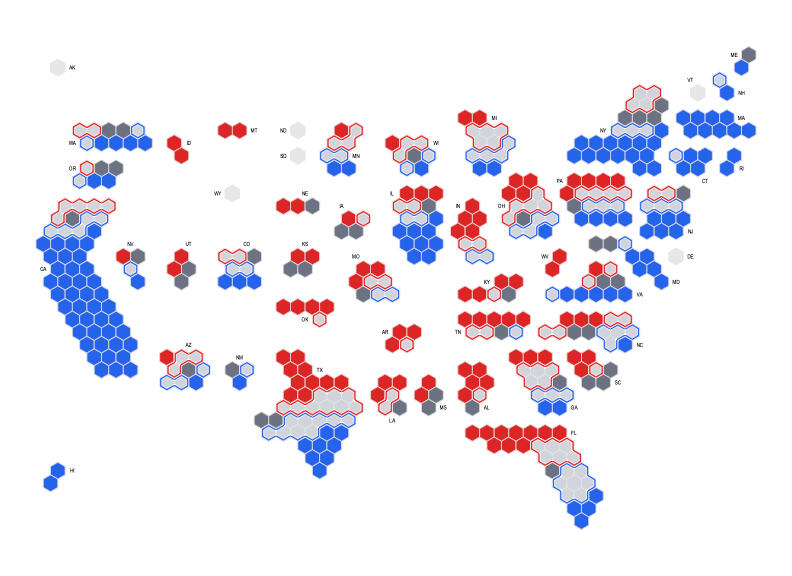A Partisan Solution to Partisan Gerrymandering:
The Define–Combine Procedure
Maxwell Palmer (Boston University), Benjamin Schneer (Harvard Kennedy School),
and Kevin DeLuca (Yale University)
The Define-Combine Procedure (DCP) is a new method for drawing redistricting plans that reduces partisan gerrymandering without requiring a neutral third party (such as an independent commission, judge, or tie-breaker) or bipartisan agreement.
Why do we need a new approach?
Partisan gerrymandering harms democratic representation. It allows parties to undermine electoral competition by drawing districts that create, enhance, or lock in a partisan advantage and shield representatives from accountability. It can make legislatures less representative of the public. Recent efforts to reduce partisan gerrymandering have yielded mixed results, such as the bipartisan commission in Virginia, which deadlocked and was not able to produce a map. In several states, litigation over partisan gerrymandering is ongoing, even in states with redistricting commissions.
What is the Define-Combine Procedure?
DCP is a new method for drawing redistricting maps that divides power between the two parties, but does not require any bipartisan cooperation. We divide the process into two simple stages, each controlled by one of the two parties.Suppose a state must be divided into 10 equal-population districts:
One party—the “definer”—draws 20 contiguous, equal-population sub-districts.
The second party—the “combiner”—selects contiguous pairs of districts from those defined by the first party to create the final districts.
The final result is 10 equally populated, contiguous districts.This process allows each party to act in their own partisan self-interest, but achieves a significantly fairer map than would be drawn by either party on its own. By dividing the responsibility into two separate steps, in which each party retains complete control, the parties counteract each other’s partisan ambitions while maintaining considerable flexibility to achieve other objectives, including maintaining compactness and communities of interest.
Why does DCP work?
DCP works by reducing the ability of either party to engage in “packing”—the strategy of putting as many supporters of the opposing party into as few districts as possible. This strategy is commonly used to give one party an advantage in competitive states, and even allows parties to win a majority of the seats without winning a majority of the vote.DCP also makes it more difficult to crack communities across two districts or to combine disparate populations from different parts of the state.By breaking the redistricting process into two steps, neither party can pack or crack the other party’s voters as effectively. When a party draws a district map on its own, it may grant itself an undue advantage; however, DCP tempers the ability of each party to engage in such behavior.
How do we know DCP works?
In our article, we show that DCP works using mathematical models and computer simulations. Using the 2020 presidential election results for every state, we ran thousands of simulations producing maps using DCP and “unilateral redistricting” where a single party controls the process. We then compared the results across four outcomes: Democrats redistricting unilaterally, Republicans redistricting unilaterally, DCP where Democrats define and Republicans combine, and DCP where Republicans define and Democrats combine. We find that DCP substantially reduces bias in favor of either party compared to unilateral redistricting.The figure below shows our results The hexagons filled in solid red represent seats always won by Republicans, and those in blue always won by Democrats. Under DCP, the gray hexagons outlined in blue and red would be those won by Democrats and Republicans, respectively. The remaining two seats would be won by the defining party.For example, in Texas, Republicans could draw a map with 8 Democratic seats and 30 Republican seats; Democrats could draw a map with 28 Democratic seats and 10 Republican seats. In theory, the control of 20 seats swings between the parties based on who draws the map. Under DCP, Democrats would win 17 seats, and Republican would win 19 seats, with two seats up-for-grabs depending on which party is the definer and combiner. Using DCP, instead of unilateral redistricting, reduces the number of seats up-for-grabs by controlling redistricting by 90%, and yields a much more representative map.

How could DCP be used?
DCP could be used by state legislatures, independent commissions, or courts when drawing new districting plans. Commissions could use DCP to produce maps without requiring bipartisan cooperation or a tiebreaker. Courts could use DCP to produce remedial maps in partisan gerrymandering disputes. State legislatures could use DCP to guide negotiations, or even to produce a final map.Map of Differences in Simulation Results by Party: This map shows how the partisan division of states differ under URP and DCP. Hexagons colored blue and red are seats that are always won by Democrats and Republicans, respectively, in both methods regardless of which party controls the process. Hexagons shaded in dark or light gray could be won by either party if they controlled URP. Hexagons in dark gray could be won by either party under DCP. The hexagons outlined in blue and red would be won by Democrats and Republicans, respectively, under DCP.